4. BioChromes¶
Research¶
Bacterial dyes - experiment¶
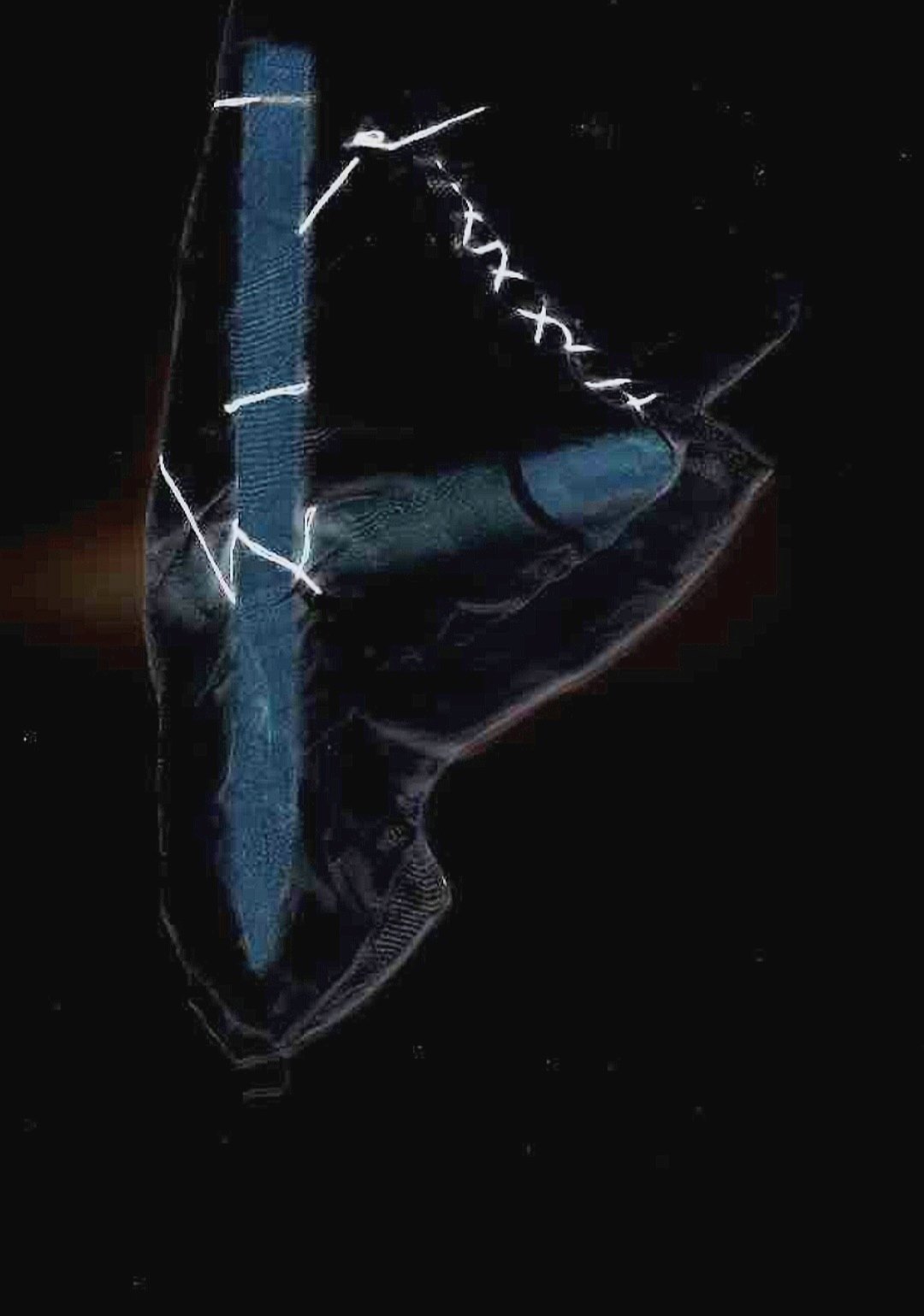
BioChromes are any pigment produces by a living organism, and this week is all about natural and bacterial dyes.The image on the right is a 'negative' (inverted) scan of a piece of fabric, stitched randomly, and with a crossed wooden stick inside. If it pans out, pink-coloured bacteria will grow into the fabric and ignore the stitches and the wooden sticks - resulting in a cool unpredicatable pattern. Though the concept of bacterial dyes may seem futuristic, their use in history dates back centuries. Ancient cultures unknowingly harnessed the power of bacteria in fermentation processes to create unique colors, such as the iconic Lincoln Green worn by Robin Hood. Today, the ancient art of bacterial dyeing has been embraced anew, weaving modern science with historical knowledge. So, welcome to the world of fermenting microorganisms who work their magic to create unique and unexpected shades.
But, how? So the fabric is put in a petri dish, sterilised, and poured over with home-made peanut butter-beef broth. Because that is what Serratia bacteria (bio safety lvl 2) love to eat. Serratia can be found in your shower; if you are someone who hates cleaning, they are the orange-pink stuff in the corners. At Fabricademy, the bacteria are bought and worked with in the Open Wetlab, a laboratory for open-source, open hardware and creative biotechnology.
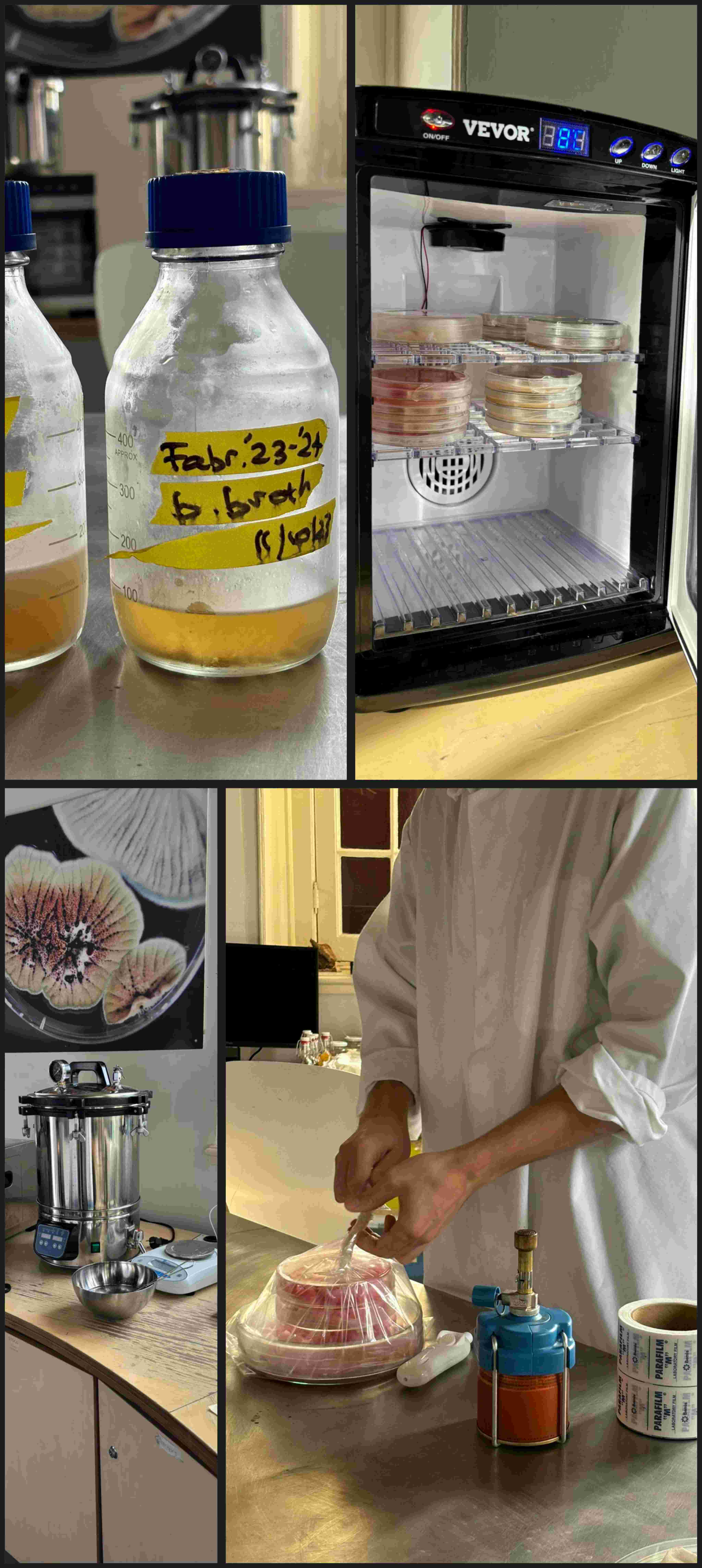
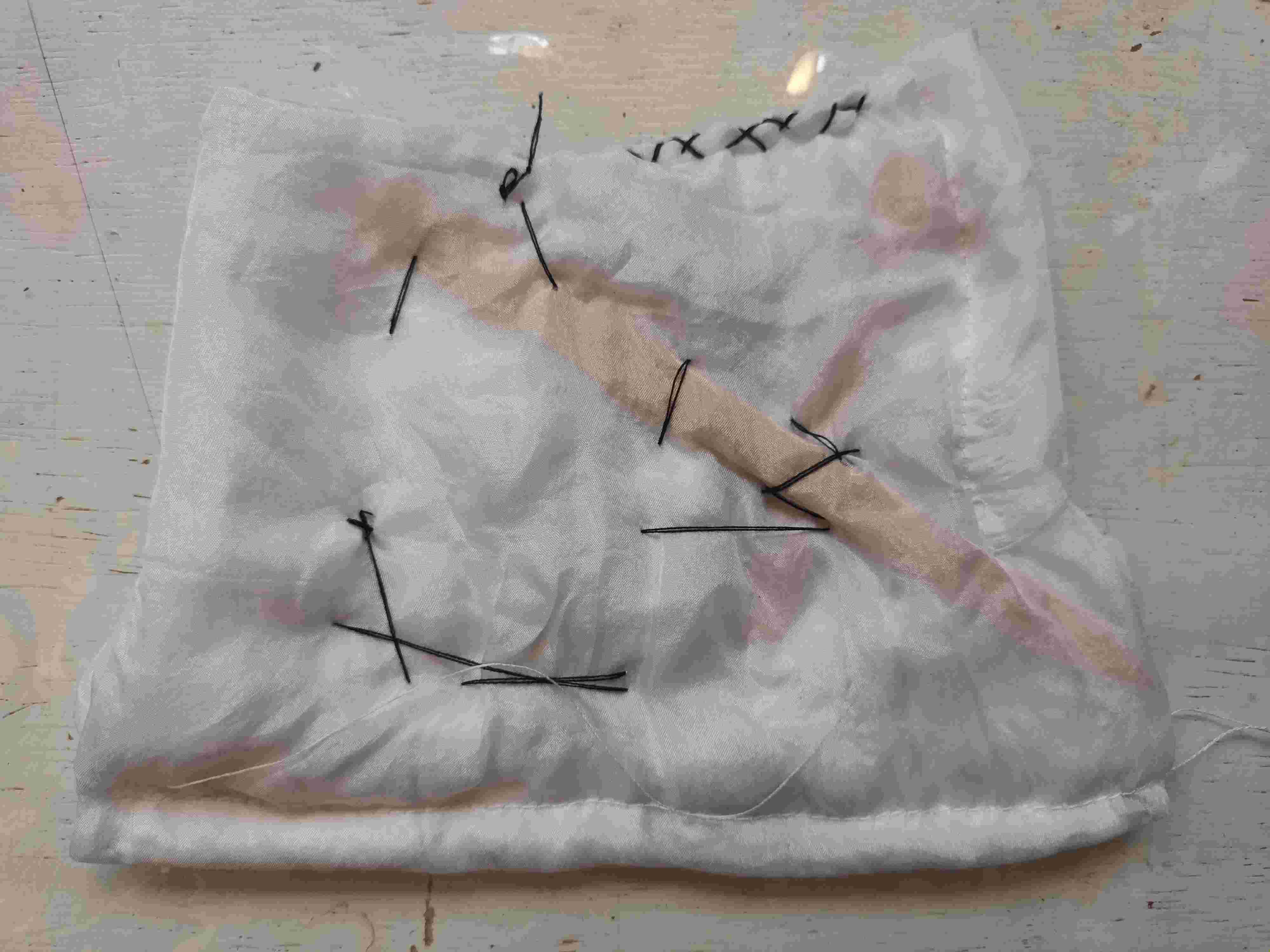



*Bacterial dyes push the boundaries of color, inspiring innovation and creativity. *
As you can see in the last picture, the bacteria ate through the stitching and also were not deterred by my wooden sticks. Too bad, it shows bacteria do not follow my instructions.
The second part is dyeing with plants and trees, the second part of this week's biochromatic assignment. In my own colourful kitchen laboratory, I experimented with natural dyeing on wool, cotton, and linen using apple peels, apple bark, apple leaves, eucalyptus bark, and eucalyptus leaves. The dye material (fabric and wool), have been mordanted with alum (Potassium Aluminum Sulphate (Alum - 10-20% weight of the fibers) I divided each batch into four groups for basic, acidic (wine vinegar), soda (alkaline/sodium carbonate), and iron modifiers, exploring how each would influence the colours.
The results are worth the chaos, though.
Inspiration for natural dyes¶
Florence Hawkins is an amazing French-British natural dye-artist who makes the most beautiful prints, using screen and block printing. In July, I did a workshop with her at Central Saint Martins.

 Work by Florence Hawkins
Work by Florence Hawkins
Experimenting with natural dyes¶
Natural Dye Material Group Project¶
This week, the wonderful Cecilia Raspanti guided us in our experiments with dyeing wool and cotton in the TextileLab in Amsterdam.

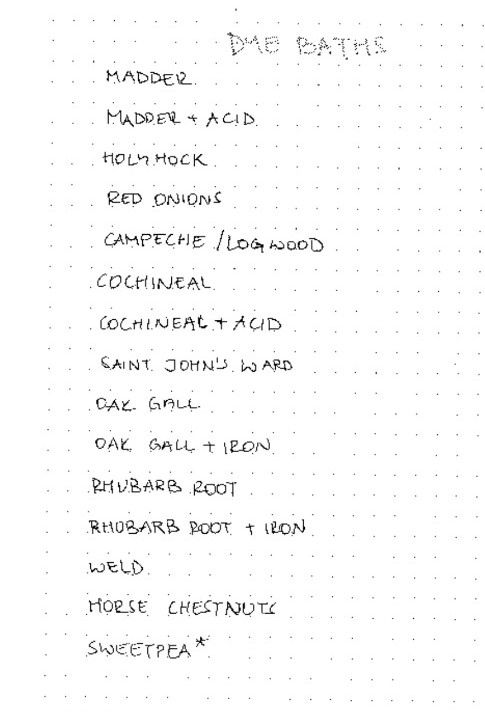

| Name | Dye Colour | Measurement | Dyestuff | Mordant | Fun Fact | Other Names |
|---|---|---|---|---|---|---|
| Sandalwood | Red | 100 % WoF | wood chips or powder | Alum | interesting for inks | Saunderswood |
| Rooibos | Soft peach | % WoF | tea leaves | Alum | ||
| Red Onion | green | 50 - 25 % WoF | skins | Alum (Copper or iron pre mordants affect colour) | contains tannins | |
| Madder | Red | 100 % Wof (red) 50 % (peach) | Roots | Both mordants and modifiers work. | Do not boil. Possibile to produce 25 shades with 1 dye bath | |
| Logwood | purple | 25 % WoF | dried chips | Alum=Purple, Iron=Dark, Copper=Blue hues | good for staining / painting | Campeche |
| St John's Wort | yellow/green | 100 % WoF | flowers, plant tops | Alum | Medicinal | Hypericum perforatum |
| Weld | Yellow (primary) | 20/30 % WoF +1/2 Sp Chalk | Stem and flower dye | Alum (copper or iron will effect final colour) | Very light and wash fast | Dyer's Rocket |
| Golden Onion | yellow/orange | 25 % WoF | skins | Alum | mix with other dyes e.g madder to intensify colour | |
| Hollyhock | pink/purple | 100 % WoF | Flowers (fresh or dry) | give pale results to vegetable fibers, react well to modifiers | ||
| Rubarb Root | yellow | 100 % (leaves), 50 % (roots) WoF | roots, leaves | natural mordant | ||
| Horse Chestnut | beige | 30 % WoF | outer shell | Alum | ||
| Cochineal | fusia/pink/purple | 5-10 % WoF | insect | Alum (brilliant colours), Cream of tartar (red) | Ground up | Carmine (lake pigment) |
| Sweet Pea | blue | 50 % WoF | flower | Alum | ||
| Alkanet | red/blue | 100 % WoF + 1 liter Ethanol (96%) | Root flakes | Alum | Extract dye using solvent (Ethanol), flakes can be extracted multiple times | |
| Avocado | gentle pink | 100 % WoF + half teaspoon Sodium Carbonate | pits (chop) and skins | soy binder | gently simmer |

__1. Madder (100% WoF)
__2. Madder + Citric Acid (1%)
__3. Red Onion (50%)
__4. Red Onion less time (cotton) / non mordant (wool)
__5. St. John's Wort (30%)
__6. Weld(60%)
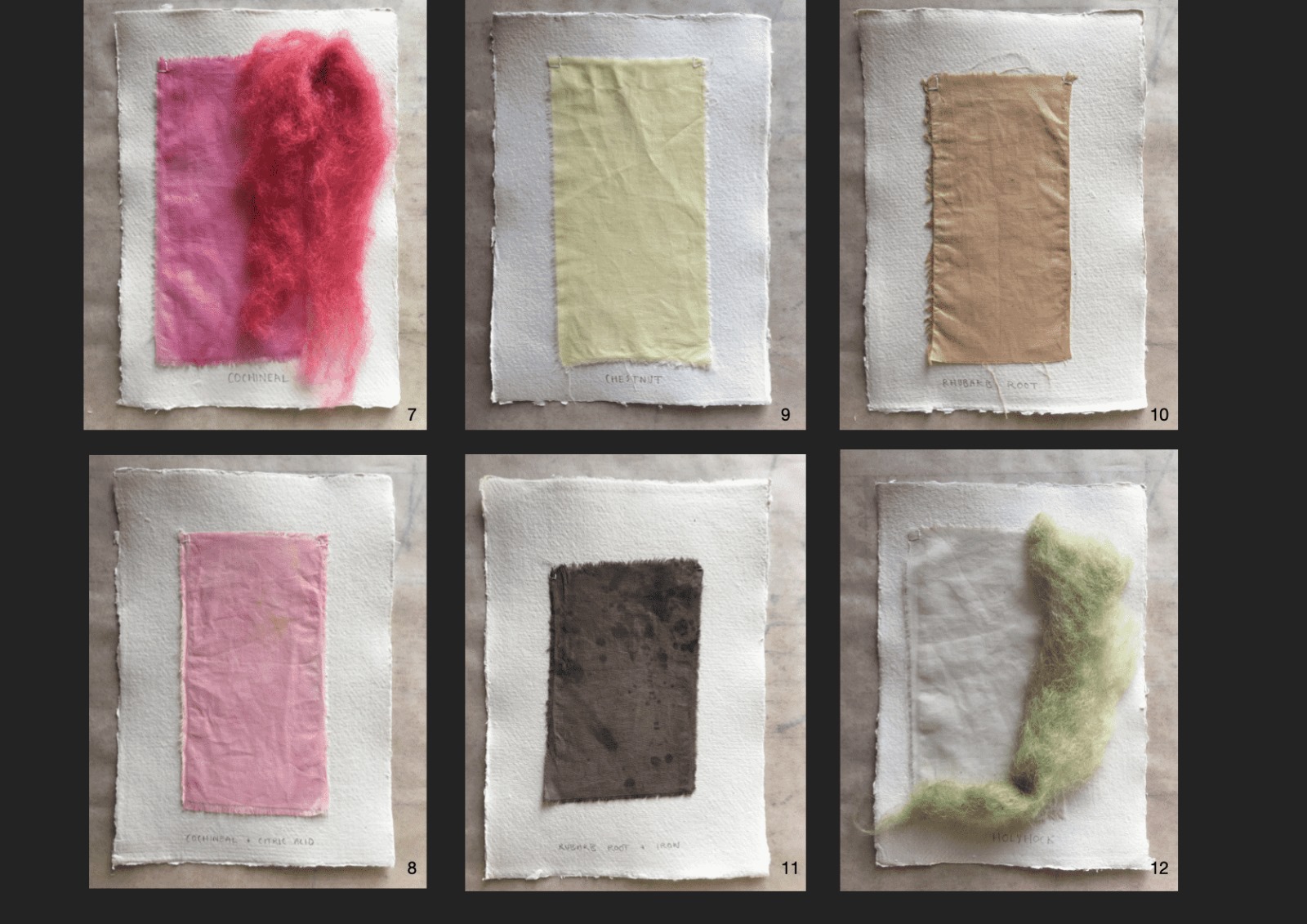
__7. Cochineal
__8. Cochineal + Cirtric Acid
__9. Horse Chestnut
__10. Rhubard Root (30%)
__11. Rhubard Root + Iron
__12. Holy Hock (20%)

__13. Oak Gall + Iron (35%)
__14. Oak Gall + Iron(gradient)
__15. Logwood
Credit pics and schematic overview: Stephanie Johnson
Process and workflow¶
Deconstructing an Apple Tree¶
For my Biochromes-experiment, I chose to 'deconstruct' two trees: the apple tree in my backyard (leaves, bark and apple peels) and eucalyptus (leaves and bark). The dyeing material was wool, linen and cotton for the eucalyptus and wool for the apple tree.

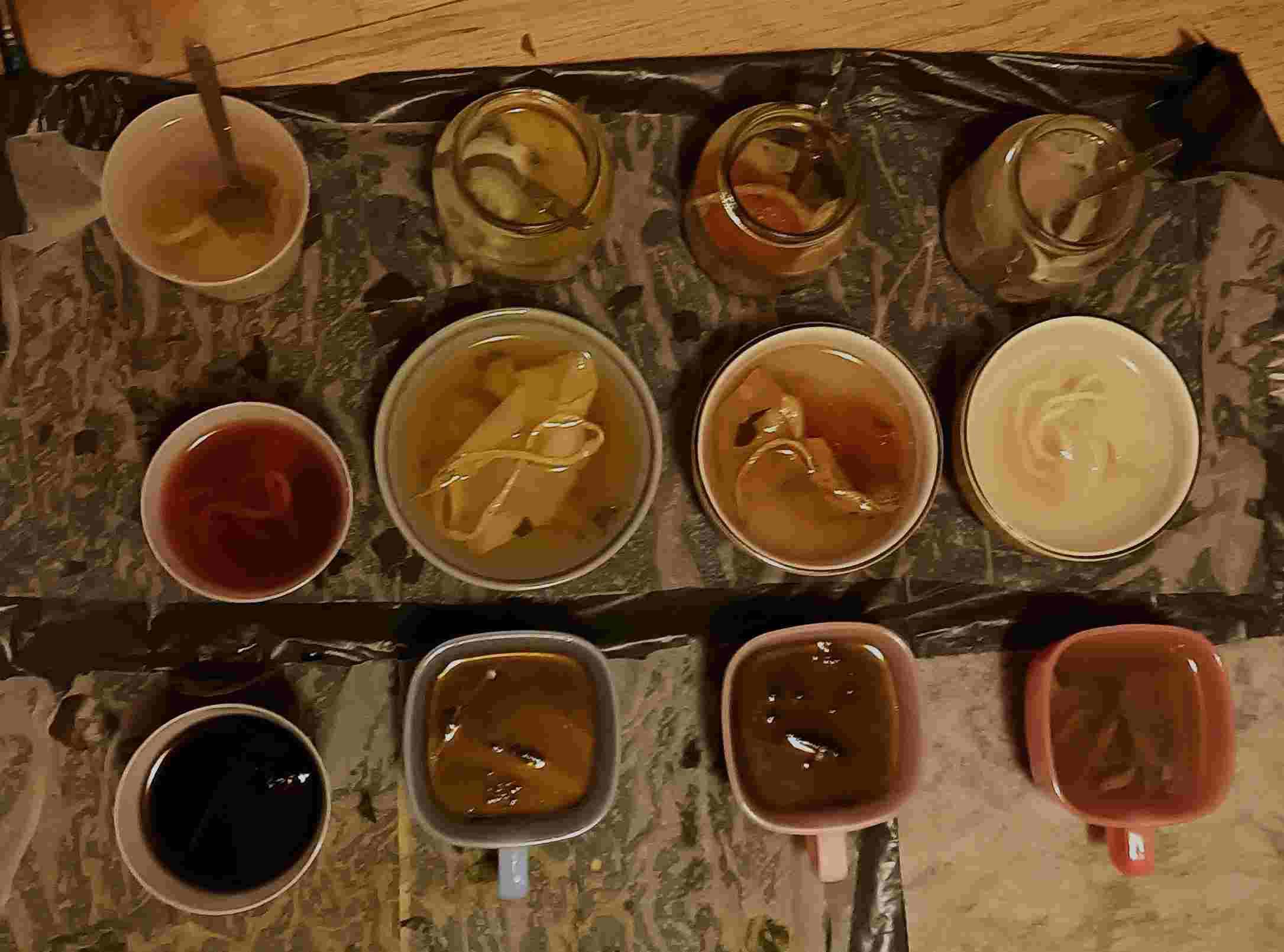
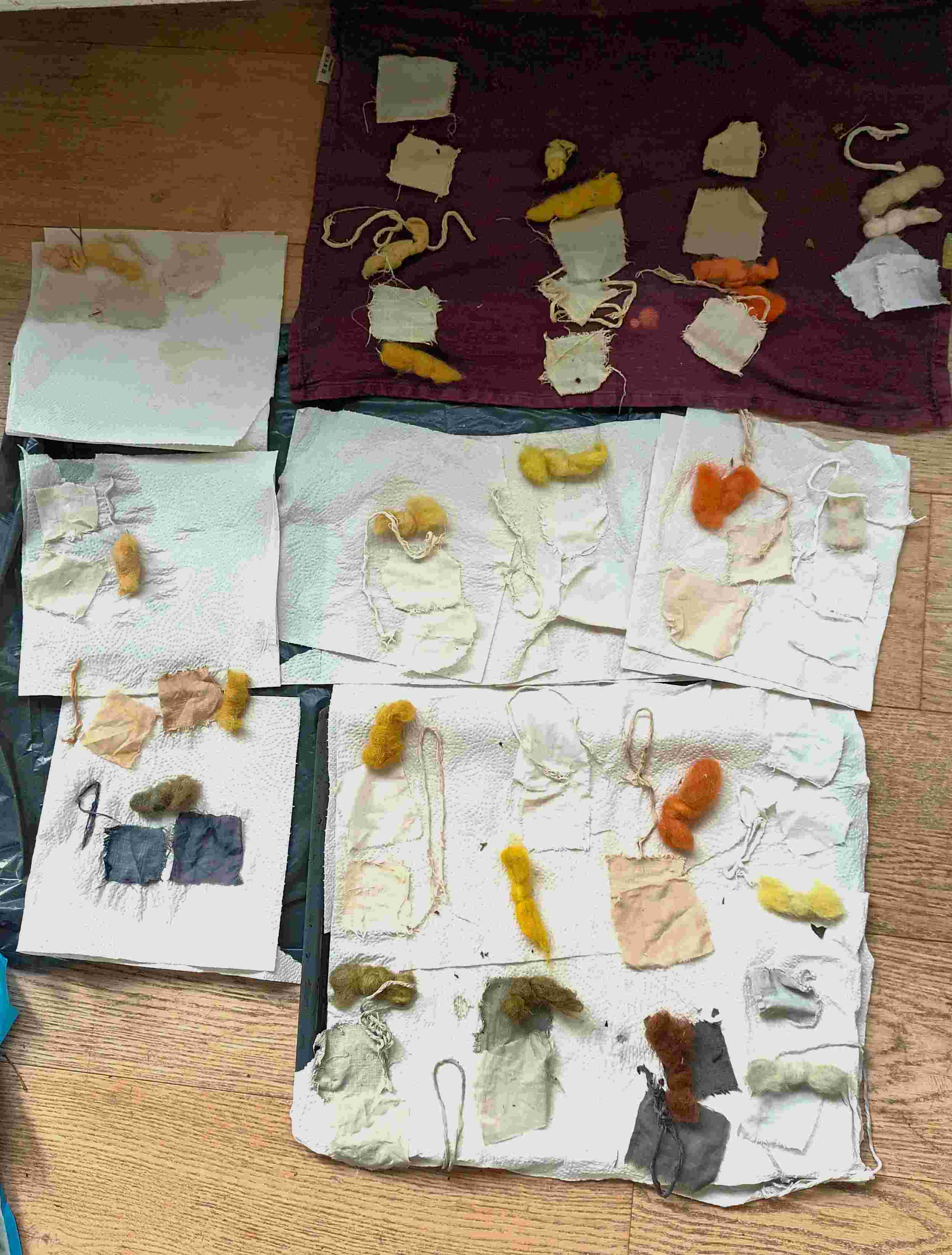

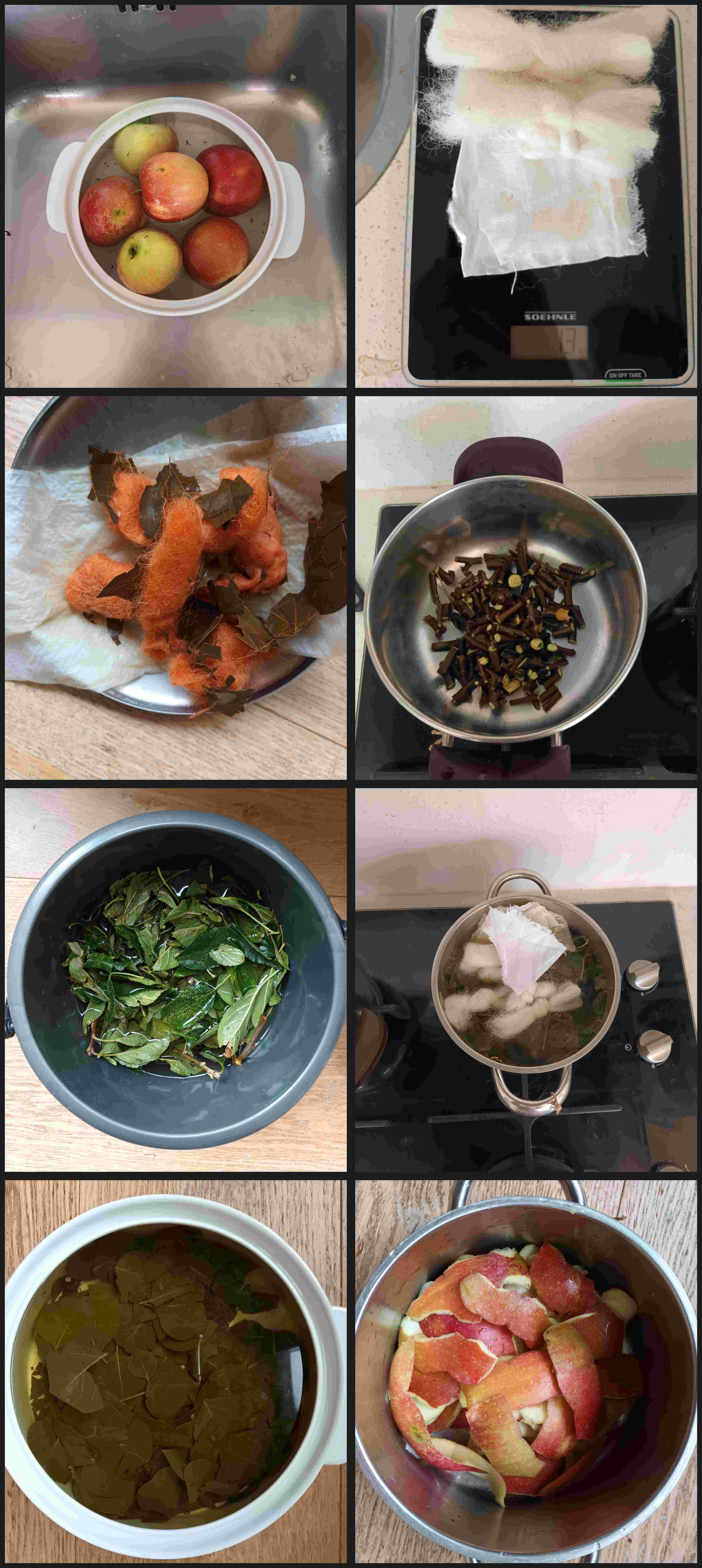
For each batch of fabric, I began with 13 grams of material. The dye bath consisted of 1 liter of water. In the first hour, I boiled the dye bath without adding the wool, linen, or cotton. Then, I added the fabric materials and let them simmer in the bath for an hour. Finally, I allowed the whole concoction to cool down for another hour.
Once the dye bath had thoroughly cooled down, I divided the materials into four distinct categories: basic, acid (enhanced with wine vinegar), soda ash, and iron.
Results¶

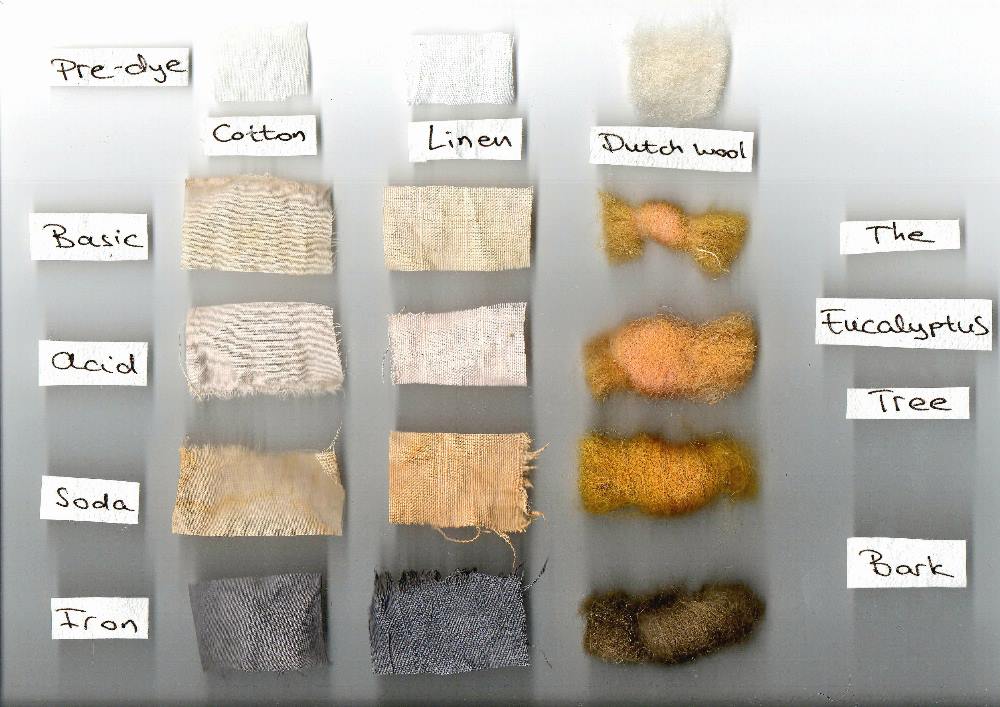
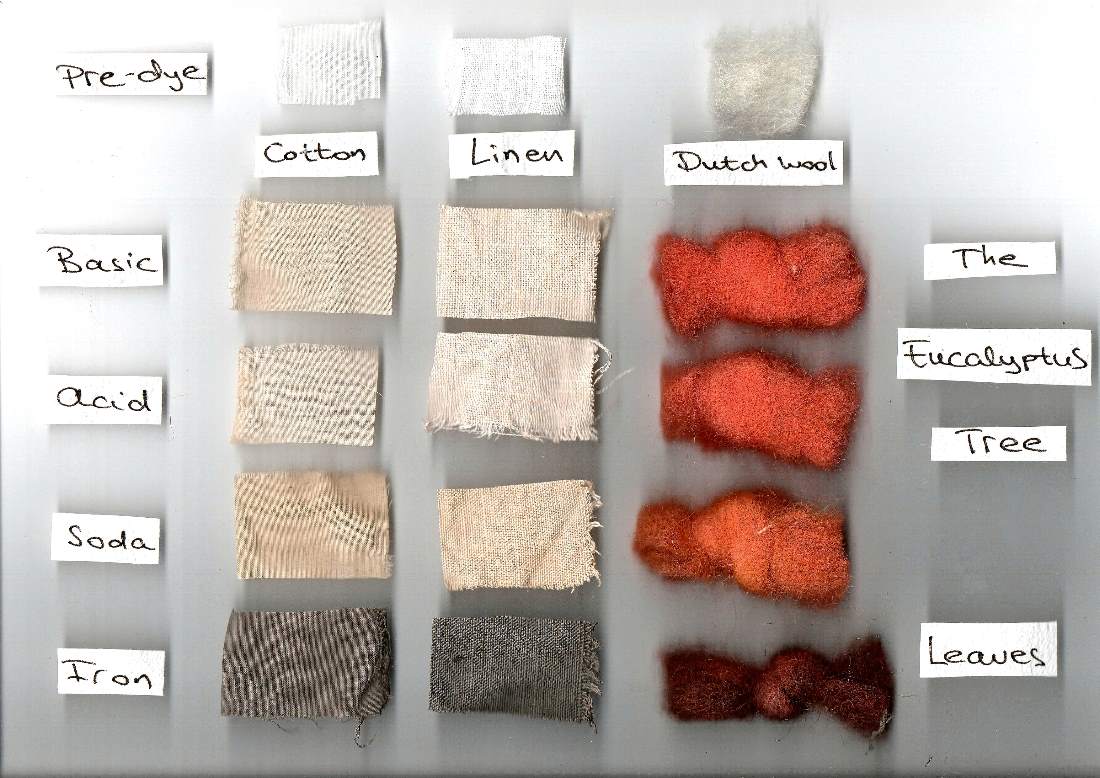
There are a few steps for dyeing with plant material and making pigments and inks.
Scouring, Mordanting and Modifiers:
1. *Scouring* ('washing') is the first step in natural dyeing, essential for removing impurities, oils, and pre-existing finishes from fabric or yarn. This improves dye absorption and colorfastness.
2. *Mordanting* is done to prepare fibers to fixate the dyes. which varies based on the fiber and desired outcome. Common mordants include alum, iron, and tannin. Afterward, materials are rinsed and dried.
3. Modifiers influence or shift the dyed material's color, adding subtleties, altering hues, or creating unique effects, enhancing creativity in natural dyeing. The most common ones are soda, acid and iron.
Differences Between Ink, Dye, and Pigment:
*Ink*: Form: Ink is a dense liquid, it is used for both writing (onto the material) and printing (into the material).
*Dye*: Form: Dye is in liquid form, often used in dye baths.It is soluble in water and penetrates the material, imparting colour throughout it.
*Pigment*: Pigment is a powder, usually insoluble in water. It is applied onto the material's surface, where it adheres and forms a layer that imparts colour to the material.
Make your own pigment from what's left over from a dye bath¶
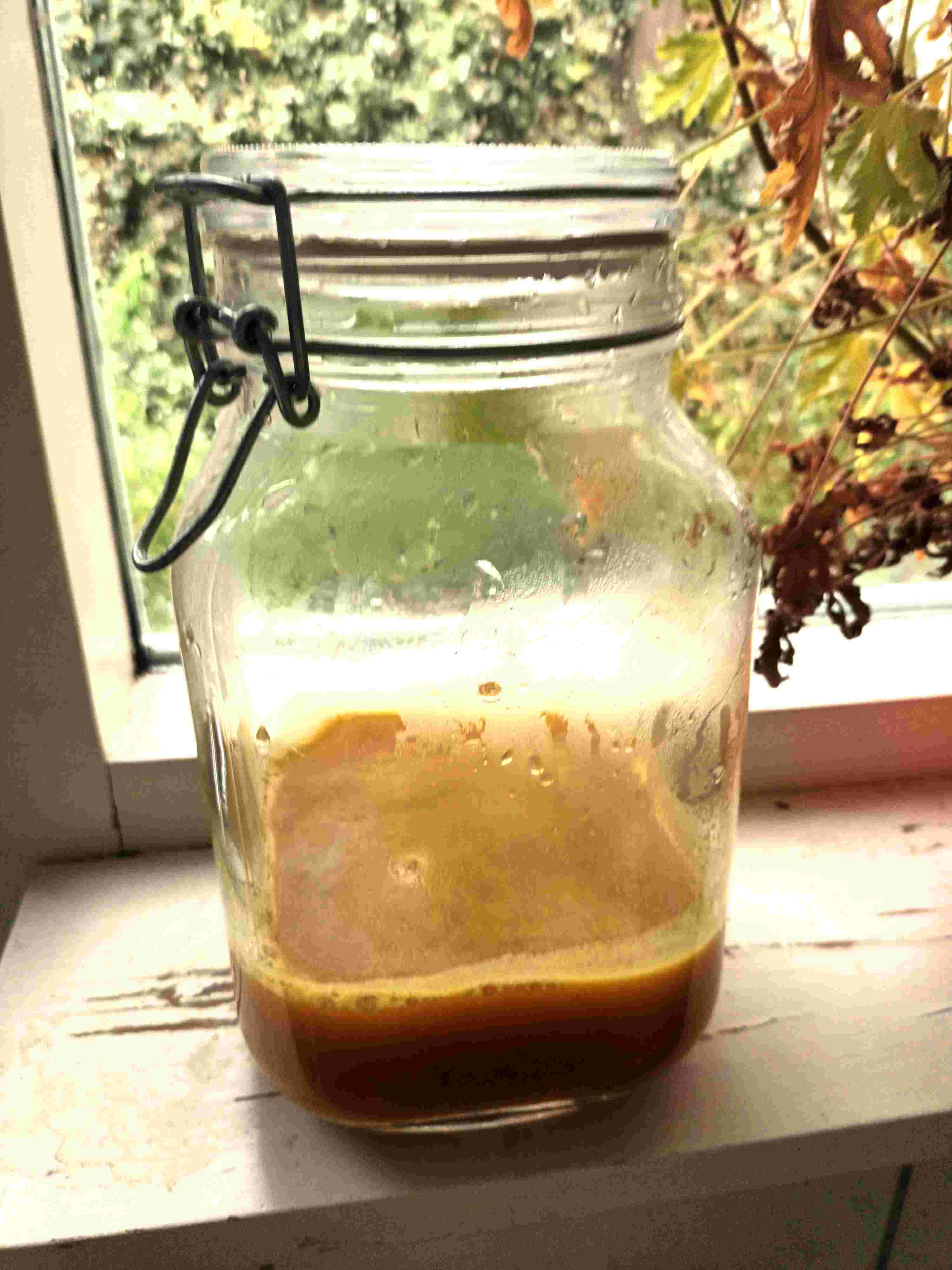

Creating pigment from the leftover residue of a eucalyptus dye bath is a wonderful way to minimize waste and extend the use of your natural dye materials. Here's a simple guide on how to make pigment from eucalyptus dye bath remnants:
Materials You'll Need:
Leftover eucalyptus dye bath (from boiled eucalyptus leaves); A container to collect the residue (a glass jar or bowl works well); Coffee filter; A small spoon or stick for stirring; A mortar and pestle or a coffee grinder; A small airtight container for storing the pigment.
After I completed the eucalyptus dyeing project, I used leftover leaves from the dye bath. For one liter of bath you need 15 grams of alum and 7.5 grams of sodium carbonate I strained it by pouring it into a coffee filter (this will leave you with the eucalyptus pulp). It came out as a mustardy yellow.
Once the eucalyptus residue is dry, use a mortar and pestle or a coffee grinder to crush and grind it into a fine powder. This will be your eucalyptus pigment.
I also extracted some colour from eucalyptus leaves with ethanol. I didn't have arabic gom, so I can't complete that process, but it came out as a beautiful green solution:

Ingredients and recipes¶
Ingredients & Recipes
I made five dye baths, each in a different pan, and Cecilia said I would die if I used my normal pans, so I bought some second hand.
Fabric has been mordanted with alum.
40 grams of eucalyptus tree leaves (the round ones) (dry) 28 grams of eucalyptus tree twigs/bark
60 grams of apple tree bark (soaked in water for appr. 36 hours) 100 gram apple tree leaves 140 grams of apple peels
per pan 13 grams of dyeing material 1 liter of water
Boil the water with the organic material for one hour Boil the water with the organic material and the fabric/wool for one hour Turn of heat source and let simmer for one hour
Then divide in four batches for modifying with acid, soda and iron (the fourth one is the basic one, without modifying).
Use two table spoons of wine vinegar for acid Use a third of a tiny tea spoon of soda Use a teeny tiny amount of iron
Bacterial dyeing¶
Using pigment-producing bacteria for textile dyeing presents a natural and sustainable alternative to conventional toxic dyes. These bacteria yield biodegradable coloring solutions that are environmentally friendly and safe for both humans and animals. This week, we conducted a cultivation of Serratia on fabric, resulting in the creation of a distinctive and unique pattern on the textile.
| Material name | Fabric composition | Breathability | Moisture-wicking abilities | Heat retention abilities | Stretchability | Washing temperatures |
|---|---|---|---|---|---|---|
| Silk | Sericin and Fibroin | High | High | Low | Low | < 40°C |
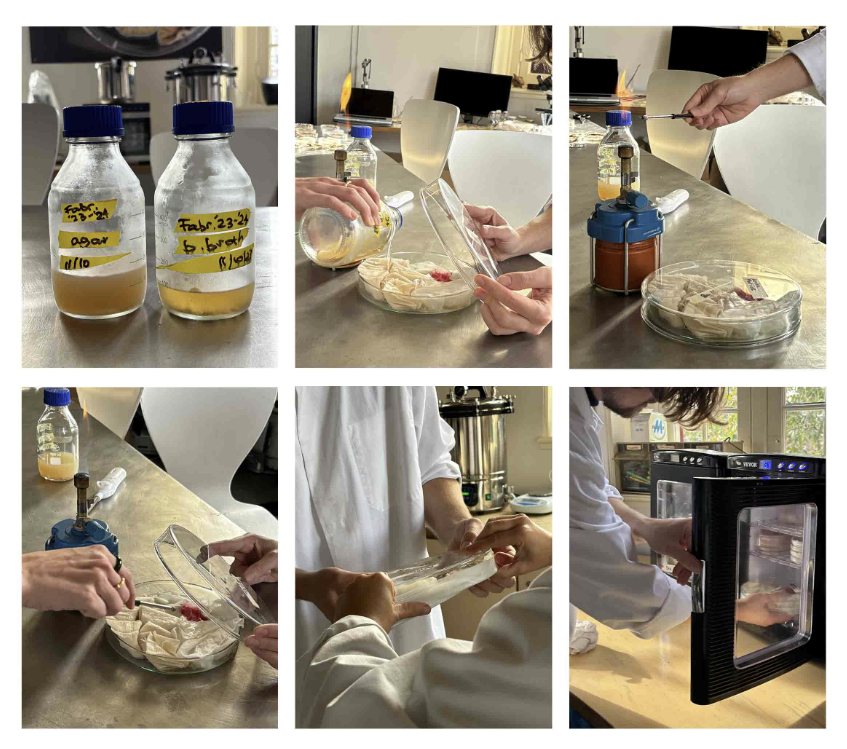
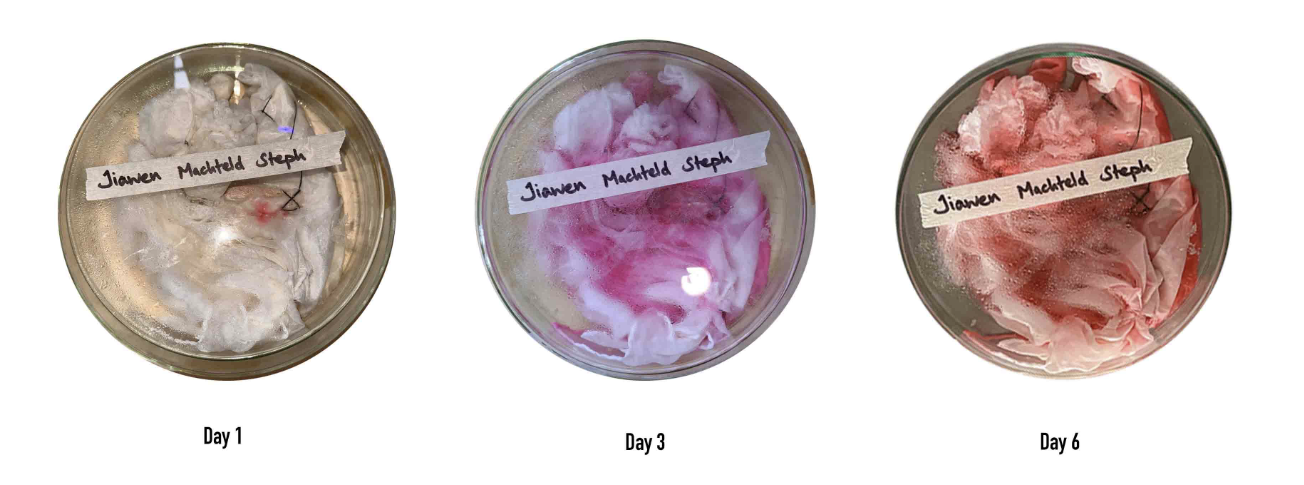
Courtesy of Jiawen Gong
So, after six days, the petri dishes with LB Broth chow had way more growth than the ones with Agar. Looks like Serratia isn't just a fan of Peanut Butter; it's also enjoying the LB Broth.
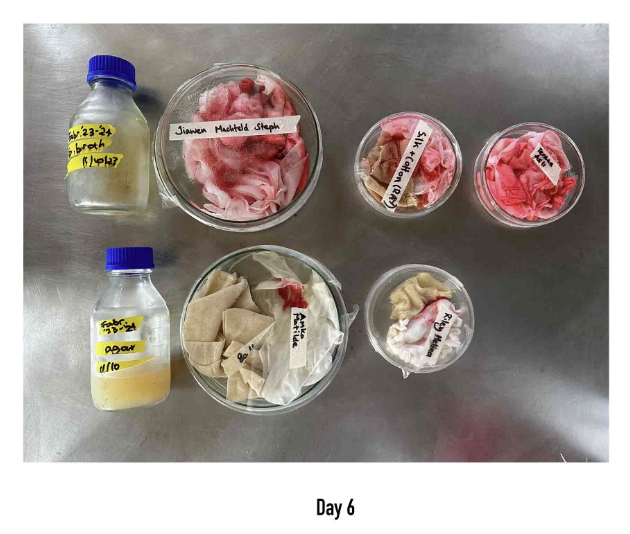
Courtesy of Ray Formilli
Tools¶
For dying fabric¶
Tools for Dyeing Fabric:
Fabric or Material: The material you want to dye, such as cotton, silk, wool, or linen.
Dye Material: Natural dye sources like plant materials (leaves, bark, roots), insects, or commercial dyes if preferred.
Large Pots or Vats: For creating dye baths and simmering the dye material.
Stirring Utensils: Spatulas or wooden spoons for mixing and stirring the dye.
Strainer or Cheesecloth: To strain out solid dye material from the dye bath. (I used a coffee filter)
Mordants: Eg. alum, to help fix the dye to the fabric.
pH Modifiers: To adjust the acidity or alkalinity of the dye bath, such as iron, soda ash or vinegar.
Heat Source: Stove or burner for simmering the dye bath.
Containers for Soaking: Bins or buckets for pre-soaking fabrics before dyeing.
Protective Gear: Gloves and aprons to protect yourself from stains and chemicals. (I didn't use them and my cuticles are still black from the iron modifier)
Measuring Cups and kitchen scale: For precise measurements of dye materials and mordants.
For making pigment¶
Tools for Making Pigment:
Dye Residue or Source: Leftover dye material, I used the leftover from eucalyptus leaves.
Container: A glass jar or a bowl for collecting the dye material.
Fine Strainer or Cheesecloth: To separate solid pigment from liquid. (Coffee filter)
Water: For rinsing and cleaning the collected residue.
Mortar and Pestle or Coffee Grinder: To grind the dried residue into pigment powder.
Airtight Container: For storing the pigment to keep it dry and protected.
For bacterial dyeing¶
Petri Dish
Autoclave
Incubator
Parafilm
Scale
Inoculation Loop
Bunsen Burner